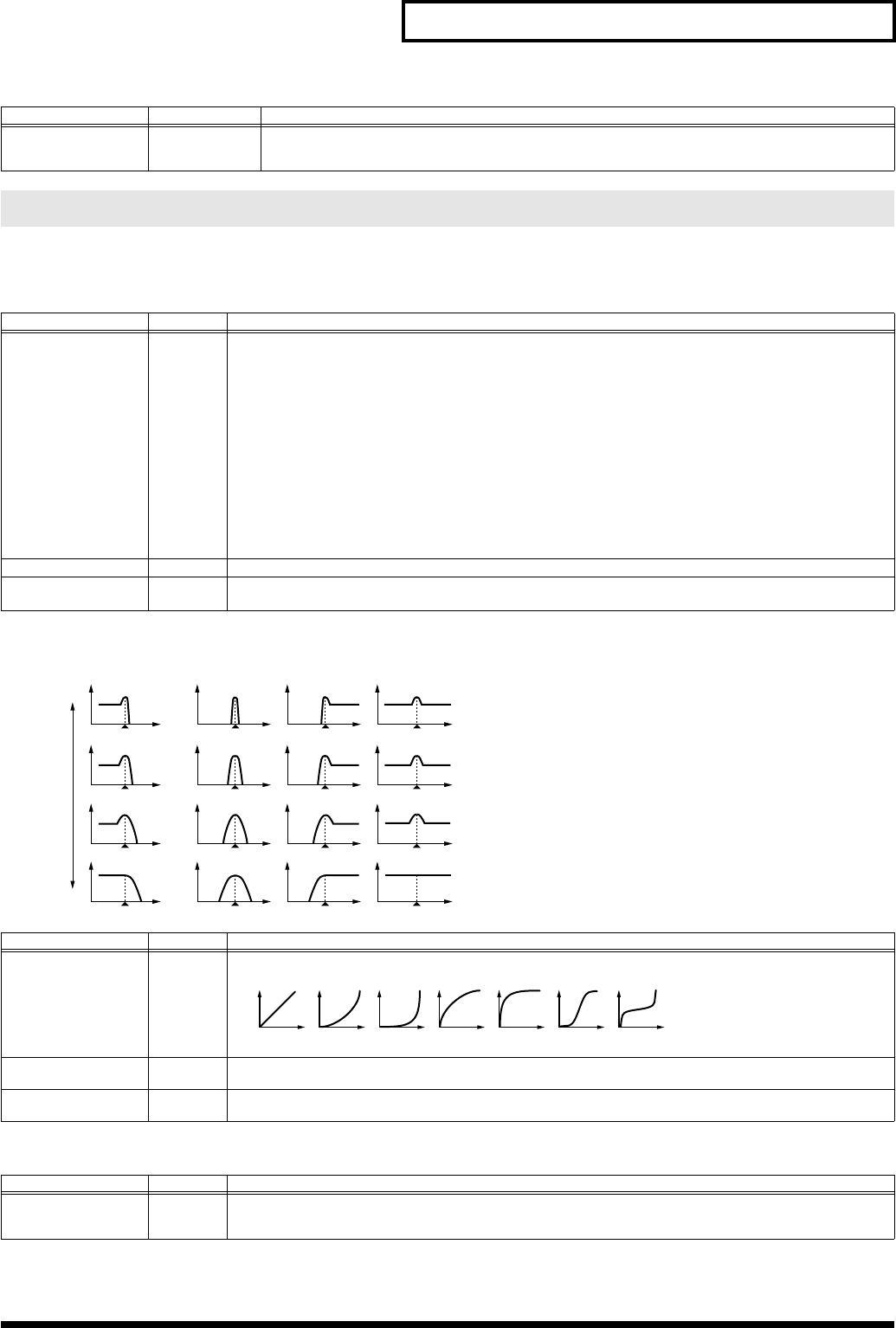
55
Creating a Rhythm Set
A filter cuts or boosts a specific frequency region to change a sound’s brightness, thickness, or other qualities.
TVF PARAMETER
TVF ENVELOPE
Velo Fade Upper
0–127 Determines what will happen to the waveform’s level when the rhythm tone is played at a velocity greater than Velo
Range Upper.
If you don’t want the waveform to sound at all, set this parameter to “0.”
Modifying the Brightness of a Sound with a Filter (TVF/TVF Envelope)
Parameter
Value Explanation
Filter Type
OFF, LPF,
BPF, HPF,
PKG,
LPF2,
LPF3
Type of filter
OFF:
No filter is used.
LPF:
Low Pass Filter. This reduces the volume of all frequencies above the cutoff frequency in order to round off, or un-
brighten the sound.
BPF:
Band Pass Filter. This leaves only the frequencies in the region of the cutoff frequency, and cuts the rest. This can
be useful when creating distinctive sounds.
HPF:
High Pass Filter. This cuts the frequencies in the region below the cutoff frequency. This is suitable for creating
percussive sounds emphasizing their higher tones.
PKG:
Peaking Filter. This emphasizes the frequencies in the region of the cutoff frequency. You can use this to create
wah-wah effects by employing an LFO to change the cutoff frequency cyclically.
LPF2:
Low Pass Filter 2. Although frequency components above the Cutoff frequency are cut, the sensitivity of this filter
is half that of the LPF. This filter is good for use with simulated instrument sounds such as the acoustic piano.
LPF3:
Low Pass Filter 3. Although frequency components above the Cutoff frequency are cut, the sensitivity of this filter
changes according to the Cutoff frequency. While this filter is also good for use with simulated acoustic instrument
sounds, the nuance it exhibits differs from that of the LPF2, even with the same TVF Envelope settings.
* If you set “LPF2” or “LPF3,” the setting for the Resonance parameter will be ignored.
Cutoff Frequency 0–127 Frequency at which the filter begins to have an effect on the waveform’s frequency components
Resonance 0–127 Emphasizes the portion of the sound in the region of the cutoff frequency, adding character to the sound.
* Excessively high settings can produce oscillation, causing the sound to distort.
Parameter
Value Explanation
Cutoff V-Curve
FIX, 1–7 Curve that determines how keyboard playing dynamics (velocity) will affect the cutoff frequency
Set this to “FIX” if you don’t want the Cutoff frequency to be affected by the keyboard velocity.
Cutoff V-Sens -63– +63 Use this parameter when changing the cutoff frequency to be applied as a result of changes in playing velocity. If you want
strongly played notes to raise the cutoff frequency, set this parameter to positive (+) settings.
Resonance V-Sens -63– +63 This allows keyboard velocity to modify the amount of Resonance.
If you want strongly played notes to have a greater Resonance effect, set this parameter to positive (+) settings.
Parameter
Value Explanation
F-Env Depth
-63– +63 Depth of the TVF envelope
Higher settings will cause the TVF envelope to produce greater change. Negative (-) settings will invert the shape of the
envelope.
Parameter
Value Explanation
LPF BPF
Resonance
HPF PKG
parameter value
Level
Cutoff frequency
Frequency
High
Low
1234567
JUNO-G_e.book 55 ページ 2006年2月13日 月曜日 午後2時44分


















